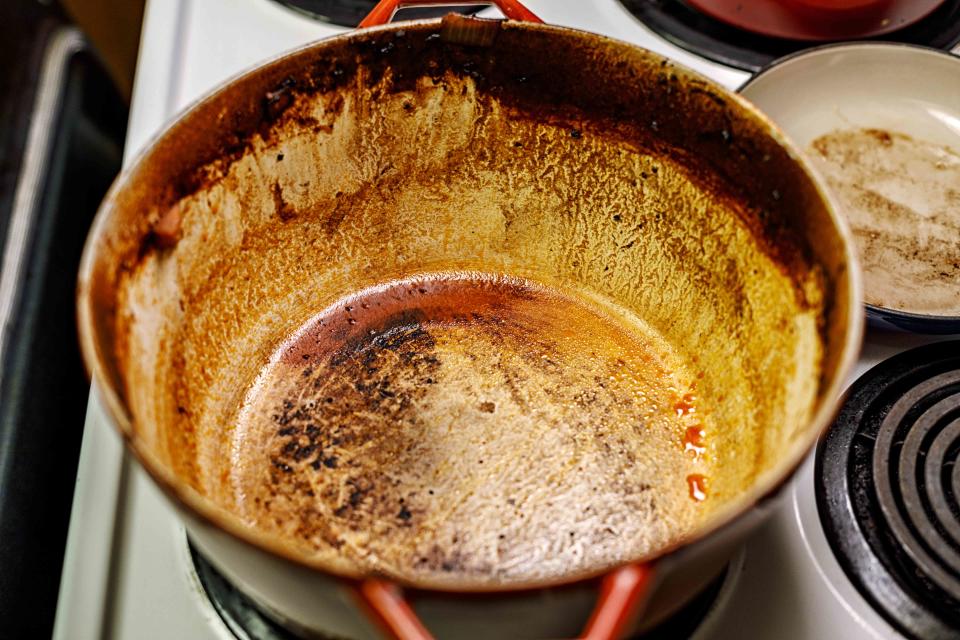How To Make A Well-Worn Enameled Dutch Oven Look (And Cook) As Good As New
It couldn't be easier to make heirloom pieces look fresh.

Getty Images
Fans of status cookware know that the Le Creuset Dutch oven is the ultimate investment piece for active home cooks. While Le Creuset isn’t the only name in the enameled cast-iron game, their elite Dutch ovens are famous for their durability; these pieces can be handed down for generations, and they’re also an exciting find on the secondhand market.
Whether you’ve just purchased a vintage Le Creuset from a garage sale or thrift shop, or you've inherited a heavily-used version from your grandmother, you can upcycle even a seriously-stained enameled Dutch oven with some smart cleanup tactics.
We asked a group of professional cleaners for their best advice on cleaning a Dutch oven, and they provided these easy and effective tips.
How To Clean an Enameled Dutch Oven
Transform your Dutch oven’s interior from dingy to sparkling with just a few basic household ingredients.
Add 1.5 liters of clean water and two tablespoons of baking soda to the Dutch oven. If you want to include white vinegar for extra cleansing power, add a hearty slug along with the baking soda. Simmer the water-baking soda mixture to further loosen the stains for 10 minutes. Then, take the Dutch oven off the flame, and pour out the water.
After emptying the water mixture, use a clean, soft cloth to scrub the interior.
Allow the pot to cool, and use soap, warm water, and a soft sponge for a final cleaning round.
To get a streak-free finish on your refurbished Dutch oven, "use a soft sponge in a circular motion. This will help avoid streaks on the surface of your enamel. Make sure [that] there is no water standing on top of your enamel after you're done cleaning it—this can cause water spots. [Also,] always use warm water—it helps dissolve grease and grime more effectively than cold water does,” recommends House Cleaning Technician Hugo Guerrero of Mattressive.
If the enamel is chipped or scratched, don’t use the Dutch oven.
While an enameled cast-iron Dutch oven with burn stains, food crust, or a coating of dust and dirt can be rehabilitated, former chef and current chief marketing officer Milo Cruz of Legend Cookware insists that, “If there are any chips or cracks in the enamel, stop using your Dutch oven, because the damage can worsen."
The existence of a chip or a scratch increases the likelihood of more scratching and chipping with further use, and these scratches also provide bacteria with a useful place to hide.
If you leave a few, very light surface scratches on your own Dutch oven (by stirring with a metal spoon or fork, for instance), then you can continue to use it as long as the scratches don’t deepen or worsen. But when dealing with a secondhand Dutch oven, it’s always better to play it safe. If you spot a scratch, then don’t bring the Dutch oven home with you.
Related:10 Things You Shouldn't Do in Your Dutch Oven
What Not To Use To Clean a Dutch Oven
Steer clear of bleach
It may be tempting to use bleach to restore the white (or off-white) enamel interior of your Dutch oven, but Cruz adamantly advises against it.
"Avoid using strong chemicals, such as bleach, on your [Dutch oven]," Cruz says. The enamel on Le Creusets and other similar Dutch ovens is delicate, and bleach that isn’t properly diluted or is left on the pot for too long can wear at the enamel and dull its shine.
Don't use abrasive scrubbers on enameled cast iron
As mentioned previously, scratches on enameled cast iron should be avoided at all costs. That’s why it’s not a good idea to use abrasive scrubbers when cleaning your Dutch oven.
Instead, “Be sure to use a soft sponge or brush and mild soap,” says recipe developer Jenny Hunter of Happy Muncher.
If bits of food or dirt are still clinging to your Dutch oven after cleaning with water, baking soda, and gentle soap, break out "a silicone scraper—it won’t damage the enamel, unlike one made out of metal,” says CEO and co-founder Toby Schulz of Maid2Match cleaning services.
Use the scraper to pry the grime away, then do another rinse and wash process. That will leave your Dutch oven in excellent, ready-to-use condition. Then, all you have to do is properly care for the Dutch oven in the future.
For more Southern Living news, make sure to sign up for our newsletter!
Read the original article on Southern Living.

